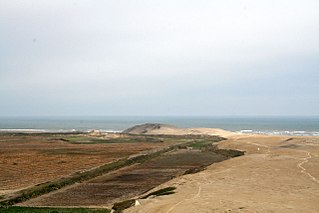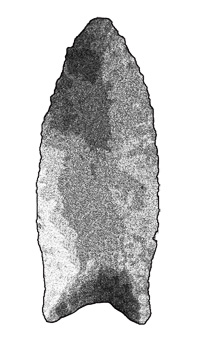Related Research Articles

In the sequence of cultural stages first proposed for the archaeology of the Americas by Gordon Willey and Philip Phillips in 1958, the Lithic stage was the earliest period of human occupation in the Americas, as post-glacial hunter gatherers spread through the Americas. The stage derived its name from the first appearance of Lithic flaked stone tools. The term Paleo-Indian is an alternative, generally indicating much the same period.
Banwari Trace, an Archaic (pre-ceramic) site in southwestern Trinidad, is the oldest archaeological site in the Caribbean. The site has revealed two separate periods of occupation; one between 7200 and 6100 BP and the other between 6100 BP and 5500 BP.
Oshara Tradition, the northern tradition of the earlier Picosa culture, was a Southwestern Archaic tradition centered in the area now called New Mexico and Colorado. Cynthia Irwin-Williams developed the sequence of Archaic culture for Oshara during her work in the Arroyo Cuervo area of northwestern New Mexico. Irwin contends that the Ancestral Puebloans developed, at least in part, from the Oshara.
The Paleo-Arctic Tradition is the name given by archaeologists to the cultural tradition of the earliest well-documented human occupants of the North American Arctic, which date from the period 8000–5000 BC. The tradition covers Alaska, and expands far into the east, west, and the Southwest Yukon Territory of Canada.
The Big Eddy Site (23CE426) is an archaeological site located in Cedar County, Missouri, which was first excavated in 1997 and is now threatened due to erosion by the Sac River.

The Stanfield-Worley Bluff Shelter, located on private property in Colbert County in northwestern Alabama, United States, is one of the most important prehistoric sites excavated in the state due to the archeological evidence deposited by the Paleo-Indians who once occupied the rock shelter. Lying in Sanderson Cove along a tributary of Cane Creek approximately seven miles (11 km) south of the Tennessee Valley, the shelter and the high bluffs of the surrounding valley provided a well-protected environment for the Native American occupants.

Prehistoric Korea is the era of human existence in the Korean Peninsula for which written records do not exist. It nonetheless constitutes the greatest segment of the Korean past and is the major object of study in the disciplines of archaeology, geology, and palaeontology.
J&J Hunt Site (8JE740) is an inundated prehistoric archaeological site located 6 km off the coast of northwestern Florida. The site which was discovered in 1989 is located in 3.7 to 4.6 m of salt water in the Gulf of Mexico along the PaleoAucilla River. In prehistory the site had at least two different occupations: a Late Paleoindian-Early Archaic and Middle Archaic. The J&J Hunt site was a major focus of the PaleoAucilla Prehistory Project conducted by Michael K. Faught.
Gills Farm Archeological District is a historic district in Randolph, Massachusetts. The district, located in a riverine environment, encompasses a collection of prehistoric archaeological sites dating from the Middle Archaic to the Woodland period. Middle Archaic components include evidence of Neville and Stark projectile points. The quantities of Late Archaic materials found in the area suggest a period of intensive occupation and use. These sites were used as tool workshops, where stone from nearby quarry sites was processed into finished objects, typically bifacial tool blades.
North American hunting technologies begins with the arrival of the Paleo-Natives and continues through to modern times. This article deals exclusively with Aboriginal Canadians and Native Americans in the United States.
The Buttermilk Creek complex is the remains of a paleolithic settlement along the shores of Buttermilk Creek in present-day Salado, Texas. The assemblage dates to ~13.2 to 15.5 thousand years old. If confirmed, the site represents evidence of human settlement in the Americas that pre-dates the Clovis culture.

Huaca Prieta is the site of a prehistoric settlement beside the Pacific Ocean in the Chicama Valley, just north of Trujillo, La Libertad Province, Peru. It is a part of the El Brujo Archaeological Complex, which also includes Moche (culture) sites.
Broken Mammoth, Alaska is an archeological site located in the Tanana River Valley, Alaska, in the United States. The site was occupied approximately 11,000 to 12,000 years ago making this one of the oldest known sites in Alaska. Charles E. Holmes discovered the site in 1989 and investigation of the site began in 1990 and excavations are ongoing to this day.

Golondrina points are lanceolate spear or dart projectile points, of medium size, dated to the transitional Paleo-Indian Period, between 9000–7000 BP. Golondrina points were attached on split-stem hafts and may have served to bring down medium-sized animals such as deer, as well as functioning as butchering knives. Distribution is widespread throughout most of Texas, and points have also been discovered in Arkansas and Mexico. The concentration of Golondrina specimens is highest across the South Texas Plains, where the point is the most prevalent of Paleo-Indian types and defines a distinctive cultural pattern for the region. The Golondrina point is so named for its flared basal corners ("ears"), which resemble a swallow's split tail. Classification of Golondrina can be difficult because of its similarity to other types, particularly the Plainview point, to which it was originally thought to be related.
Dust Cave is a Paleoindian archaeology site located in northern Alabama. It is in the Highland Rim in the limestone bluffs that overlook Coffee Slough, a tributary of the Tennessee River. The site was occupied during the Pleistocene and early Holocene eras. 1LU496, another name for Dust Cave, was occupied seasonally for 7,000 years. The cave was discovered in 1984 by Dr. Richard Cobb and initially excavated in 1989 under Dr. Boyce Driskell from the University of Alabama.
Hidden Falls is an archaeological site that contains evidence for the earliest occupation in Southern Alaska along with evidence of marine resource usage. It is dated to the Archaic and Pacific period, between 9,500 and 1800 B.C.

Chipped stone crescents are a class of artifact found mainly associated with surface components of archaeological sites located in the Great Basin, the Columbia Plateau, and throughout California. Although their distribution covers a large portion of the western United States, crescents are often found in similar contexts in close proximity to water sources including playas, lakes, rivers, and mainland and island coast lines. Crescents are generally thought to be diagnostic to the terminal Pleistocene and early Holocene and are representative of assemblages that include fluted and stemmed projectile points.

The Archaic period, also known as the preceramic period, is a period in Mesoamerican chronology that begins around 8000 BCE and ends around 2000 BCE and is generally divided into Early, Middle, and Late Archaic periods. The period is preceded by the Paleoindian period and followed by the Preclassic period. Scholars have found it difficult to determine exactly when the Paleoindian period ends and the Archaic begins, but it is generally linked with changing climate associated with the transition from the Pleistocene to the Holocene epochs, and absence of extinct Pleistocene animals. It is also generally unclear when the Archaic period ends and the Preclassic period begins, though the appearance of pottery, large-scale agriculture, and villages signal the transition.
The Archaic period is traditionally viewed as a long, transitional interval between the hunter-gatherers of the Paleoindian period and the proliferation of agricultural villages in the Preclassic. This period is known for the domestication of major Mesoamerican crops, the development of agriculture, and the beginning of sedentism. The major developments in agriculture and sedentism during this time allowed for the rise of complex societies in the region. These developments were not uniform throughout Mesoamerica and often differed regionally.
Soro Mik'aya Patjxa is a high-altitude archaeological site located in the Ilave Basin in Peru, about 30 km (19 mi) west of the current shoreline of Lake Titicaca. Soro Mik'aya Patjxa was a seasonal residential site that was reused consistently by hunter-gatherers over a period of over a thousand years.

West African hunter-gatherers, West African foragers, or West African pygmies dwelled in western Central Africa earlier than 32,000 BP and dwelled in West Africa between 16,000 BP and 12,000 BP until as late as 1000 BP or some period of time after 1500 CE. West African hunter-gatherers are archaeologically associated with the West African Microlithic Technocomplex. Despite its significance in the prehistory of West Africa, the peopling of various parts of Western Africa from the Sub-Saharan regions of coastal West Africa and the forests of western Central Africa often goes overlooked.
References
- Peabody Museum of Archaeology and Ethnology, Harvard University